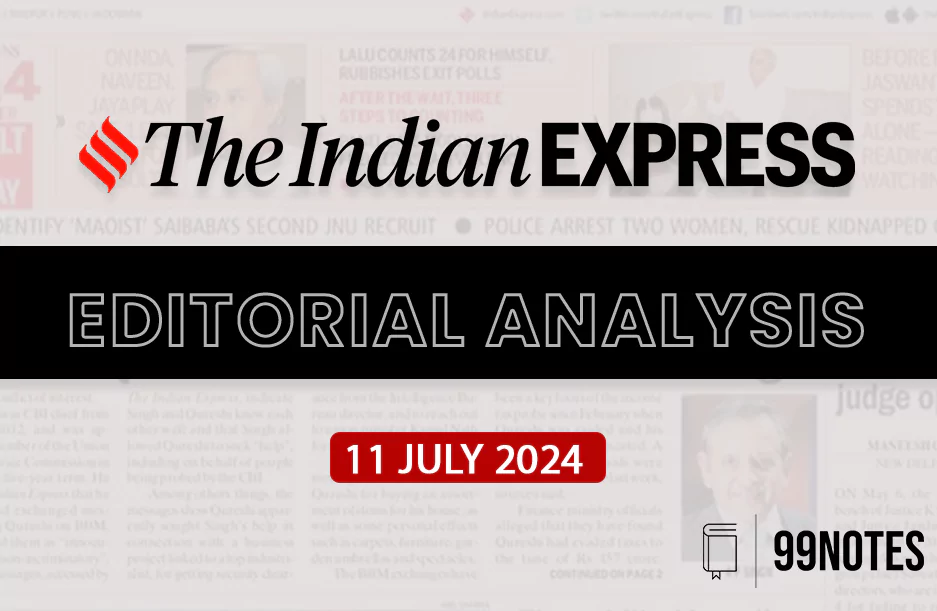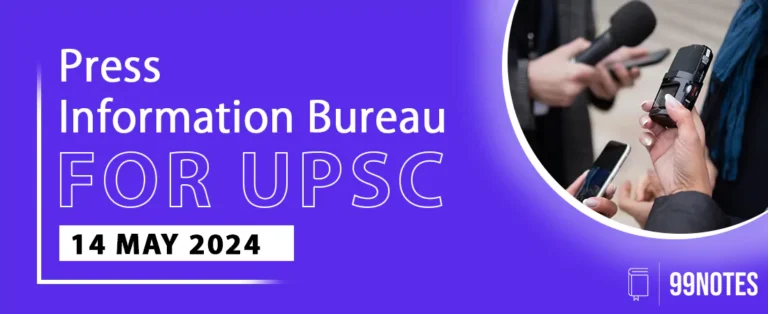11 July 2024 : Indian Express Editorial Analysis
1. The food price constraint
(Source: Indian Express; Section: The Editorial Page; Page: 10)
| Topic: GS3– Indian Economy |
| Context: |
|
What is Inflation?
- Inflation refers to the overall increase in the prices of goods and services, coupled with a decrease in people’s purchasing power.
- This means that when inflation rises (without an equivalent rise in your income), you are able to buy fewer things than you could buy previously, or you have to pay more money for the same stuff now.
- A “rising” inflation rate implies that the rate (at which the prices rise) itself is increasing.
- For example, if the inflation rate was 1% in March, 2% in April, 4% in May, and 7% in June, it shows a continuous acceleration in the rate of price increases.
Causes of Inflation
Demand-Pull Inflation:
- It occurs when the demand for goods and services surpasses the supply. When there is high overall demand in the economy, consumers are willing to pay more for available goods and services, causing a general increase in prices.
Cost-Push Inflation:
- Cost-push inflation is fueled by a rise in the production costs of goods and services, this can result from factors such as increased incomes, elevated costs of raw materials, or disruptions in the supply chain.
Wage-Price Inflation:
- This form of inflation is often characterised as a feedback loop between wages and prices, when workers demand higher wages, businesses may raise prices to offset the increased labour costs and consequently, workers seek higher wages in response, perpetuating the cycle.
Stubborn Food Inflation
- Despite the positive trends in GDP and core inflation, food inflation remains persistently high.
- Food prices have been a significant contributor to the overall consumer price index (CPI), which restricts the ability of the RBI’s Monetary Policy Committee to lower the CPI to their target of 4 percent from the current 4.8 percent.
- Historically, food commands nearly 40 percent weight in the CPI basket, making it a crucial factor in controlling overall inflation.
Historical Context of Food Inflation
- Looking back at historical data, food inflation has played a pivotal role in the overall inflation rates.
- For instance, in the years when CPI approached 4 percent, food inflation was notably below 4 percent.
- The period from 2000 to 2006 saw the most stable inflation rates, with an average CPI of 3.9 percent and food inflation at 2.5 percent.
- However, post-2006, there have been only a few instances where headline inflation dipped below the target, and this was primarily due to significantly low food inflation.
Post-Pandemic Surge in Food Inflation
- The COVID-19 pandemic further exacerbated food inflation, with the average food inflation between 2020-2021 and 2023-2024 standing at 6.4 percent, surpassing the overall CPI inflation of 5.9 percent.
- In the 50 months since the first lockdown, food inflation has remained above 4 percent for 39 months and even above 6 percent in 28 months.
- The persistent high food inflation has been a critical barrier to achieving the RBI’s inflation targets.
Challenges and Expectations
Climate Change and Monsoon Patterns
- Historically, the monsoon has been a key determinant of food prices in India. However, climate change has introduced greater uncertainty and additional weather shocks affecting agriculture.
- This year’s above-normal monsoon predicted by the India Meteorological Department brings some hope, but its distribution remains uncertain.
- Moreover, the all-India rainfall deficiency was recorded at 11 percent below the long period average as of June 30. Adequate and well-distributed rains are essential for stabilizing food prices.
Structural Issues in Agriculture
- Weather shocks like heatwaves and unseasonal rains have increased in frequency and severity, impacting food production and prices.
- Heatwaves affect crop yields by depleting groundwater levels, damaging crops, and increasing pest infestations.
- Unseasonal rains disrupt harvesting and transportation, adding to food inflation pressures.
- Addressing these issues requires structural changes in agricultural practices and infrastructure.
Policy Measures and Fiscal Support
- Mitigating the impact of climate change on food prices will necessitate a combination of monetary and fiscal policies.
- Enhancing agricultural infrastructure, promoting climate-resistant crop varieties, and incentivizing agricultural research are crucial steps. Investments in irrigation infrastructure and cold storage facilities will help reduce food wastage and stabilize prices.
- The upcoming Union Budget should focus on intensifying efforts in these areas to address the structural issues contributing to high food inflation.
Conclusion
- Controlling food inflation is essential for achieving the RBI’s inflation targets and maintaining economic stability.
- While monetary policy has limited capacity to address the structural issues causing high food inflation, coordinated efforts between monetary and fiscal policies are needed.
- Addressing climate change impacts, improving agricultural infrastructure, and promoting research and development in agriculture are critical for achieving durable low inflation and supporting overall economic growth.
| What are Various Government Initiatives to Control Food Inflation? |
|
| PYQ: There is also a point of view that agriculture produce market committees (APMCs) set up under the state acts have not only impeded the development of agriculture but also have been the cause of food inflation in India. Critically examine. (200 words/12.5m) (UPSC CSE (M) GS-3 2014) |
| Practice Question: Discuss the challenges and strategies for managing food inflation in India, considering the diverging economic trends of GDP growth and core inflation. How does climate change impact food inflation, and what measures can be taken by both monetary and fiscal policies to address these issues effectively? (250 words/15 m) |
2. Russia razor’s edge
(Source: Indian Express; Section: The Ideas Page; Page: 11)
| Topic: GS2 – International Relations – Bilateral Relations |
| Context: |
|
Prime Minister Narendra Modi’s recent visit to Russia has exemplified India’s adeptness at navigating complex geopolitical landscapes. The visit showcased India’s ability to maintain stable and beneficial relationships with major global powers while addressing divergent international expectations. Modi’s positive remarks about Russia and President Vladimir Putin emphasized the strong political synergy and the potential for expanded economic and scientific cooperation. The aim to reach a trade turnover of $100 billion by 2030 highlights the ambitious future of Indo-Russian relations. |
Contrasting Views on Ukraine and Military Purchases
- The visit also brought to light differing perspectives on the Ukraine conflict and military cooperation.
- Modi’s candid statements on Ukraine, emphasizing peace and the pain of innocent casualties, contrasted with the lack of significant military purchases from Russia.
- His remarks resonated widely, indicating India’s stance on peace and diplomacy.
- Despite these differences, the visit signified a strong endorsement of India-Russia ties, even amid the ongoing conflict in Ukraine and the growing Western pressure to reduce relations with Russia.
Strategic Agreements and Shared Goals
Ukraine Conflict and Peaceful Resolution
- Modi’s discussions with the Kremlin led to important agreements, such as the release and safe return of Indians serving in the Russian armed forces.
- The joint statement emphasized resolving the Ukraine conflict through dialogue and diplomacy, aligning with international law and the UN Charter.
- Although India may not immediately take on a mediation role, this stance could serve as a foundation for future negotiations between Russia and Ukraine, possibly facilitated by international stakeholders.
Russia-China Relations and Indo-US Ties
- The informal talks between Modi and Putin also likely covered Russia’s growing relationship with China.
- Modi would have sought to understand any shifts in Moscow’s position on India-China relations, especially concerning border clashes.
- While the specifics of these discussions remain private, Russian Foreign Minister Sergei Lavrov’s recent comments suggest no change in Russia’s traditional stance.
- Similarly, Putin would have sought reassurances about India’s growing ties with the US, ensuring they do not negatively impact Indo-Russian relations.
Economic and Trade Dynamics
Trade Growth and Sanctions Impact
- Despite Western sanctions, India-Russia trade has surged from $10 billion before February 2022 to $65.7 billion in the last financial year.
- This growth is largely driven by India’s increased purchase of discounted Russian oil.
- However, this has led to payment challenges and a significant trade imbalance favoring Russia, currently over $50 billion.
- The revival of rupee-rouble transactions accounts for nearly 60 percent of payments, but further measures are needed to address the imbalance and facilitate smooth trade operations.
Potential Growth Areas and Connectivity Projects
- The joint statement from the visit hints at new payment mechanisms and identifies potential growth sectors for Indian exports, such as agriculture and automobiles.
- Additionally, both countries agreed to enhance efforts on key connectivity projects, including the International North-South Transport Corridor, the Chennai-Vladivostok route, and the Arctic Ocean Northern maritime corridor.
- These initiatives are expected to bolster trade and economic cooperation.
Military Cooperation and Production
Addressing Interruptions and Delays
- The discussions also touched on military cooperation, particularly addressing the interruptions in military spares and delays in weapon deliveries.
- The joint statement suggests that these issues will be resolved by setting up production units in India under the ‘Make in India’ initiative.
- This approach aims to make military cooperation more resilient and self-sufficient, reducing dependency on direct imports and fostering domestic production capabilities.
Conclusion
Future Prospects of Indo-Russian Ties
- Contrary to some experts views, the India-Russia relationship is not in “terminal decline.”
- The Modi-Putin dialogue indicates a concerted effort to strengthen bilateral ties in light of current geopolitical realities and mutual limitations.
- The future stability of Indo-Russian relations will depend on how deeply both countries can integrate into each other’s national development projects.
- The successful visit underscores the resilience and adaptability of this consequential partnership, navigating the complex global landscape while prioritizing mutual growth and cooperation.
| What are the Key Highlights of the 22nd India-Russia Annual Summit? |
|
Diplomatic Achievements:
Economic Cooperation:
Defence and Technology:
Transport and Connectivity:
Global Issues: Climate Change:
Counter Terrorism:
|
| PYQ: Recently, India signed a deal known as ‘Action Plan for Prioritization and Implementation of Cooperation Areas in the Nuclear Field’ with which of the following countries? (2019) (a) Japan (b) Russia (c) The United Kingdom (d) The United States of America Ans: B |
| Practice Question: Evaluate the outcomes and implications of Prime Minister Narendra Modi’s recent visit to Russia on India-Russia bilateral relations. How does this visit reflect India’s approach to managing complex geopolitical dynamics, particularly in the context of the Ukraine conflict, Russia-China relations, and Western pressures? (250 words/15 m) |




